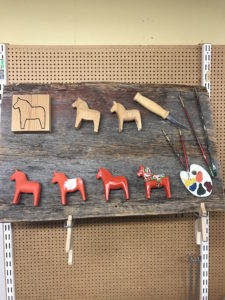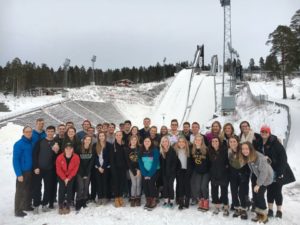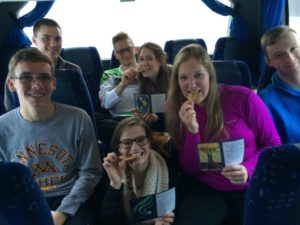Today we traveled from Mora, Sweden to Stockholm, Sweden. They warned us before we started our journey that it would be a five hour drive. This was followed by a lot of deep sighing. Fortunately for us, the trip lasted an additional two and a half hours. We were thrilled. Along the way, we made plenty of stops including, but not limited to, a Dalecarlian Horse factory, a potty break, a lunch break, a break to stretch, and a break to take a picture in front of a ski jump which looked very similar to the other 453 ski jumps we have taken pictures in front of so far (if you would like proof, take a quick glance at the group Facebook page). In between the various stops, we also had class where two groups presented on Gustavus Adolphus (the person and the school) and the Nobel Prize. While the trip was long and full of snarky comments from all sides of the bus, it was worth every stop.
At approximately 10:00 am, our bus departed from the Mora hotel. At approximately 10:20 am, we all got off again. The Nils Olsson Hemslöjd ab factory may not sound super cool, but trust us, it was worth every Dala spent in the gift shop. The factory is one of the two biggest Dala horse, pronounced Dalahäst in Swedish, factories in the world. This was also mentioned in the cleverly named “I’ll Have Some Mora That” blog by Isaiah and Lucas (for those of you who haven’t had the chance to read their post, well, read it). To add on to their post, the Dala horse became one of the most famous symbols of Sweden after a 6 meter Dalahäst was placed in front of a pavilion at the World Fair in New York in 1939. After becoming a huge success (pun not intended), the next year, 20,000 Dalecarlian horses were made and shipped to New York. The horses quickly became a symbol of Sweden.
When we arrived at the factory, we were told that we couldn’t immediately start shopping much to everyone’s despair. However, we were then quickly introduced to Mattias, the grandson of the founders of the company, Nils and Johannes Olsson. He told us the story of his grandparents who started the simple company in a bakery house in 1928. During this time, they did not have the luxury of outlets, so all of the horses were entirely hand-crafted. The company produced between 500-1000 horses per year which is almost, but not quite, comparable to the current yearly average of 80,000-120,000 horses. This is done through the work only of 60 carvers and 10 painters. After the brief history lesson, Mattias introduced us to one of these workers who demonstrated how they carve each individual horse. Many of us agreed, if we tried to copy his carving technique, we would have a lot less fingers. Mattias also told us the journey each horse makes. They start as simple trees (pine or alder to be exact). After being cut down, the wood is shaped first using a band saw before being individually hand-carved with a special knife. A water-based paint is then applied twice to each animal before being covered with filler. Sandpaper is then used for the first time on the horses to remove any imperfections. The water-based paint is used once again before the horses go through the decoration process. While the horse is the most popular animal manufactured here, the company also sells roosters and pigs. The roosters started up at the same time as the horses, but the pigs were added on in the 1960’s to be used as piggy banks. If you wanted a pig but are afraid piggy banks are out of style, have no fear, they now make ones with slots big enough to fit credit cards.

Perhaps the main attraction of this site, at least for our group, was the gift shop. The store sold Dala horses, pigs, roosters, moose, and basically any other kind of Swedish souvenir you could think of. The size of the horses ranged from as small as 1 cm to as large as 1.7 m. And if for whatever reason you are unsatisfied with the Dala animals produced by this company, you may walk out the front door and head thirty yards to the right (or 27.432 meters since we are not in the U.S. anymore) and you will find their main competitor. However, based on the size of the check-out line, if you are a parent, relative, or friend to someone on this trip you will most likely not need to visit the stores at all, as (spoiler alert) you will probably be receiving one as a souvenir upon our return.
With everyone’s wallets a bit lighter, we piled back onto the bus to continue our journey. As we were all mentally preparing to be seated for the next 5 hours of our lives, we stopped yet again. “Let’s get a group shot” has become one of the most common phrases heard from Dr. Bank’s on this trip, and so it was no surprise to hear it when a ski-jump could be spotted out the windows of the bus. The ski-jump that was graced with our presence today was located at the Lugnet Hills sports complex in Falun, Sweden which is the occasional home for the ski-jumping and cross country skiing World Cups. Sports are apparently taken very seriously in Falun, seeing how their complex has 6 indoor fields, two swimming pools, a tennis hall, an athletics arena, an indoor and outdoor ice hockey arena, a bandy field and a curling hall. Oh, and the two full size ski-jumps included in the picture below. All of this was admired and adored by all of us for the less than two minutes we were there. The picture looks great though.

Back on the bus we went. After a brief get-to-know-everyone-on-the-bus game, Hannah and Emily Hilk taught the group about a familiar character. Gustav Adolf (known as Gustavus Adolphus II to us common folk) was one of the most renowned kings of Sweden. During his reign, which began in 1611 when he was merely 17 years old, he expanded Sweden into the third largest country in Europe. His death, in 1632, occurred while he was leading his armies in the Thirty Years’ War. He has been an inspiration to war leaders from every era and is even nicknamed “The Father of Modern Warfare”. While many Gusties know that our school was founded in 1862, many are not aware that it did not become Gustavus Adolphus College until 1873 and wasn’t in its current location in St. Peter until 1876. The original name given to the college by Eric Norelius (sound familiar?) was Minnesota Elementarskola and it was located in Red Wing. Today, “The Golden Gusties” is a tribute to King Gustav, who, in his time, was known as the “Lion of the North”. After the presentation, we got to get out our creative sides and make family crests for ourselves.
All of the learning called for a bathroom/lunch break. Once on the bus again, we continued the get-to-know-everyone-on-the-bus-game before Calleigh and Josie taught us about the Nobel Prize. Alfred Nobel was born in Stockholm, Sweden. While he is most known as the creator of the Nobel Prize, he was also the inventor of dynamite. This invention came after his brother was killed in an explosion because he wanted to find a safer explosive. However, when his brother died, a French newspaper accidentally printed Alfred’s obituary and negatively spoke about his invention of dynamite. Alfred became worried that people would remember him in a negative light and thus, the Nobel Prizes were born. He established a will that put his fortune into a fund to support the Prizes each year and thought it was important they be presented to the best candidate despite their nationality. The presenters also talked about the Gamla Stan which is a square in Stockholm we will be visiting tomorrow. After the presentation, several students were awarded The Nobel Prize for Taking Bus Quizzes after correctly answering the most questions about the Nobel Prize.

The remainder of the bus ride included Mafia, WordBrain, and lots and lots of napping. What seemed like four days later, we finally arrived at our hotel where we ate dinner and then had free time to explore the area (or in our case, write a blog).
Overall, today may not have been the most exciting, but we still managed to learn a ton and have a good time. A trip is pretty impressive if even the dull moments are mush mush (slang term used on this trip to replace basically any word, but in this case, great). We can’t wait to see what tomorrow has in store.
You stay classy San Diego!
Brandon Snoberger and Matt Blomquist